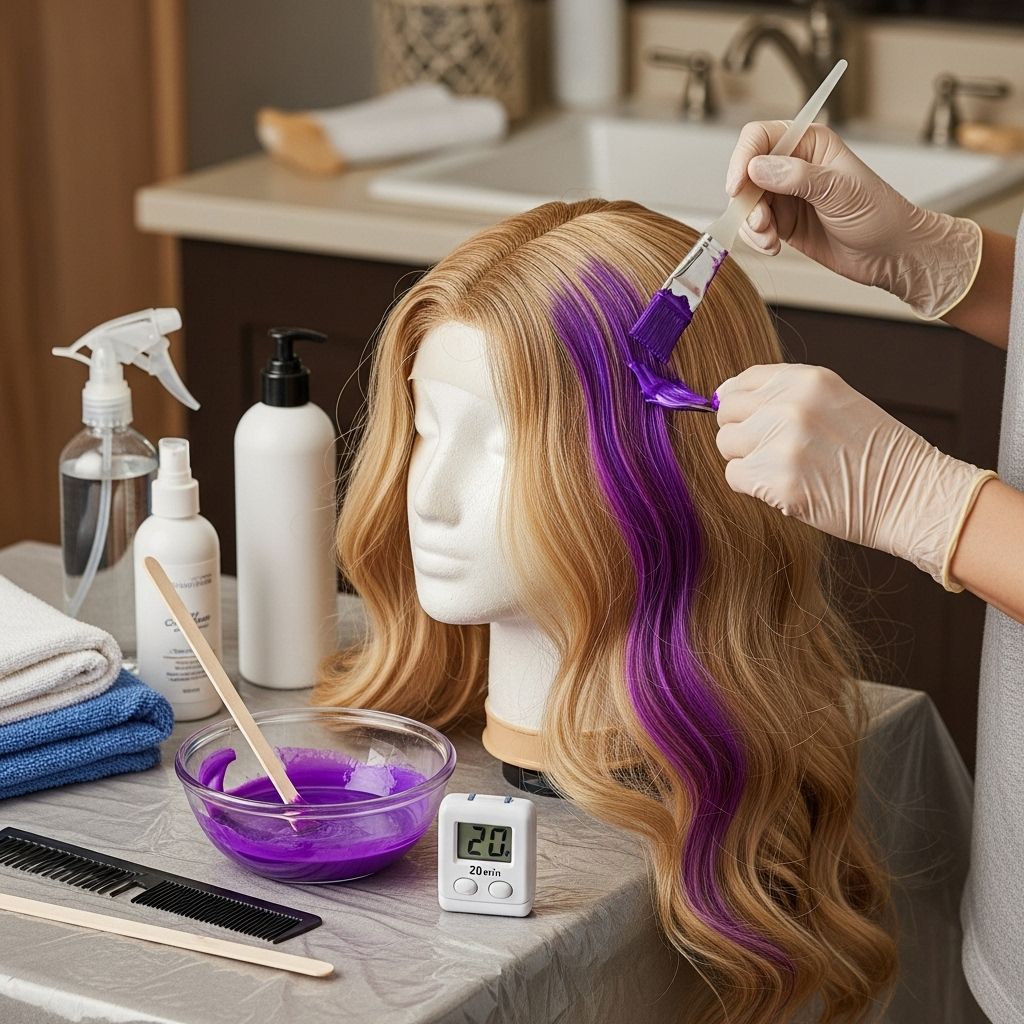How to Dye a Wig at Home: A Step-by-Step Guide for Perfect Color
Transform your look with beautifully colored hair—here’s exactly how to dye a wig at home, safely and stylishly.

Introduction
Dyeing a wig at home is an excellent way to refresh your style or match a new look. Whether you want to go bold, go natural, or cover up faded color, the process is achievable with the right tools, technique, and patience. This guide will walk you through everything you need to know—from preparation to aftercare—to ensure your wig comes out vibrant, healthy, and ready to wear.
What You Need Before You Begin
- Human hair wig (synthetic wigs cannot be dyed with traditional hair dye)
- High-quality hair dye made for human hair wigs
- Developer (if required by your dye formula)
- Plastic mixing bowl and tinting brush
- Clips for sectioning hair
- Styling gel (to protect lace front)
- Plastic gloves
- Towels
- Hair conditioner
- Optional: Hair detangler, wide-tooth comb
Preparing Your Wig for Dyeing
Detangling and Cleaning
Start by gently brushing out your wig to remove tangles and knots. Using a detangler can help, especially for longer or denser wigs. If there are any products or styling residues, lightly shampoo the wig and let it dry completely before proceeding.
Preparing the Workspace
Lay your wig flat on a protected surface. If you have a mannequin head, pin the wig to it for easier dye application.
Protecting the Lace
If your wig has a lace front, apply styling gel to the lace and blow-dry it on a cool setting or let it dry thoroughly. This prevents dye from staining the lace, which can be difficult to remove.
Choosing the Right Dye
| Type of Dye | Best For | Longevity | Developer Needed |
|---|---|---|---|
| Permanent | Darkening, covering grays, dramatic color changes | Long-lasting | Yes |
| Semi-permanent | Refreshing color, temporary changes, pastels | Several weeks | No |
| Watercolor/Dip Dye | Creative, fashion colors, ombre, pastels | Temporary/fades quickly | No |
Tip: Always do a strand test before dyeing the whole wig to ensure you like the color and to check for any hair damage.
Step-by-Step Guide to Dyeing Your Wig
Mixing the Dye
Follow the dye manufacturer’s instructions. For permanent dye, mix 1 part dye with 1 part developer in a plastic bowl. For watercolor/dip dye, add semi-permanent dye to hot water in a basin until you reach your desired color intensity.
Applying the Dye for Classic Color
- Divide your wig into sections using clips.
- Wear gloves and start applying dye from the roots to the ends, using a tinting brush or comb for even coverage.
- Be careful not to apply dye to the lace or wig cap.
Watercolor/Dip Dye Method
- Submerge the wig fully into the basin of colored water.
- Gently swirl or stir for even coverage.
- Leave in for 10–30 minutes, checking color periodically.
Processing the Dye
Let the wig process for the time recommended by the dye manufacturer. Do not exceed the recommended processing time, as this can damage the hair fibers.
Rinsing and Conditioning
Rinse the wig thoroughly with cold water until the water runs clear. Apply a deep conditioner to restore moisture and shine, then rinse again.
Drying and Styling
Gently blot excess water with a towel and let the wig air dry completely on a wig stand. Once dry, style as desired, using heat-protectant products if you plan to use hot tools.
Tips for Success
- Section your wig for even color application.
- Protect surfaces from dye stains by covering your workspace.
- Be gentle with the hair fibers to avoid tangling and breakage.
- Don’t rush—take your time for best results.
- Consider professional help for complex color transformations.
Maintaining Your Dyed Wig
Dyed wigs require extra care to maintain color vibrancy and hair health.
- Use shampoos and conditioners formulated for color-treated hair.
- Wash less frequently to preserve color.
- Use cold water for washing to prevent fading.
- Store your wig on a wig stand to maintain shape.
Frequently Asked Questions
Can I dye synthetic wigs at home?
No, traditional hair dyes do not work on synthetic wigs. Only human hair wigs can be dyed with regular hair dye.
How do I prevent dye stains on lace fronts?
Apply styling gel to the lace before dyeing and let it dry completely. This barrier will help protect the lace from stains.
How do I know if my wig is human hair?
Human hair wigs feel like natural hair, can be heat-styled, and usually cost more than synthetic wigs. Check the packaging or consult your retailer.
Can I use regular hair dye on wigs?
Yes, as long as the wig is 100% human hair and the dye is designed for human hair.
How often can I dye my wig?
Repeated dyeing can damage the hair. Try to minimize dye sessions and use conditioning treatments in between.
How can I remove hair dye from the wig cap?
If dye accidentally stains the cap, rinse immediately. For stubborn stains, try a gentle stain remover on a cloth, being careful not to rip the lace or mesh.
Common Mistakes to Avoid
- Dyeing a synthetic wig
- Not protecting the lace or cap
- Skipping the strand test
- Over-processing the hair
- Rinsing with hot water
Conclusion
Dyeing your wig at home is a creative and fun way to change up your look. With the right preparation, technique, and aftercare, you can achieve beautiful, salon-quality results. Remember, patience and attention to detail are key—and when in doubt, consult a professional for advice.
References
- https://noellesalon.com/blogs/hair-color-style/step-by-step-how-to-dye-a-wig-human-hair
- https://www.lorealparisusa.com/beauty-magazine/hair-color/hair-color-tutorials/how-to-watercolor-wig
- https://xrsbeautyhair.com/blogs/hair-blog/how-to-dye-a-wig
- https://shop.mayvenn.com/blogs/blog/how-to-dye-a-human-hair-wig
- https://www.youtube.com/watch?v=do85PAHBiaM
- https://www.youtube.com/watch?v=wGPpKuvaVCc
Read full bio of medha deb












